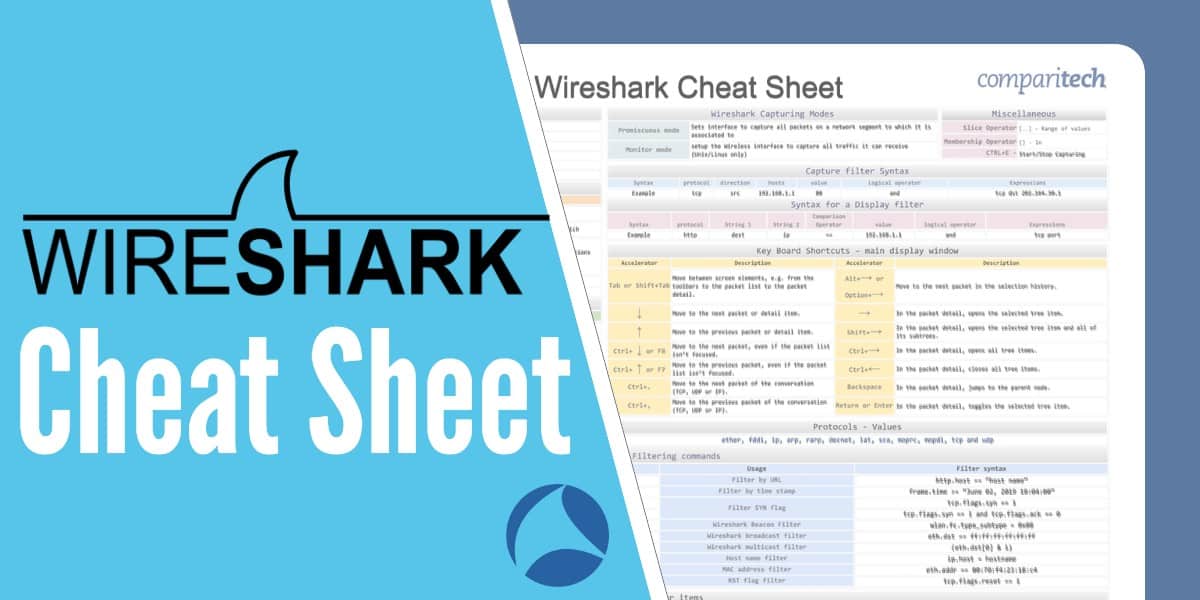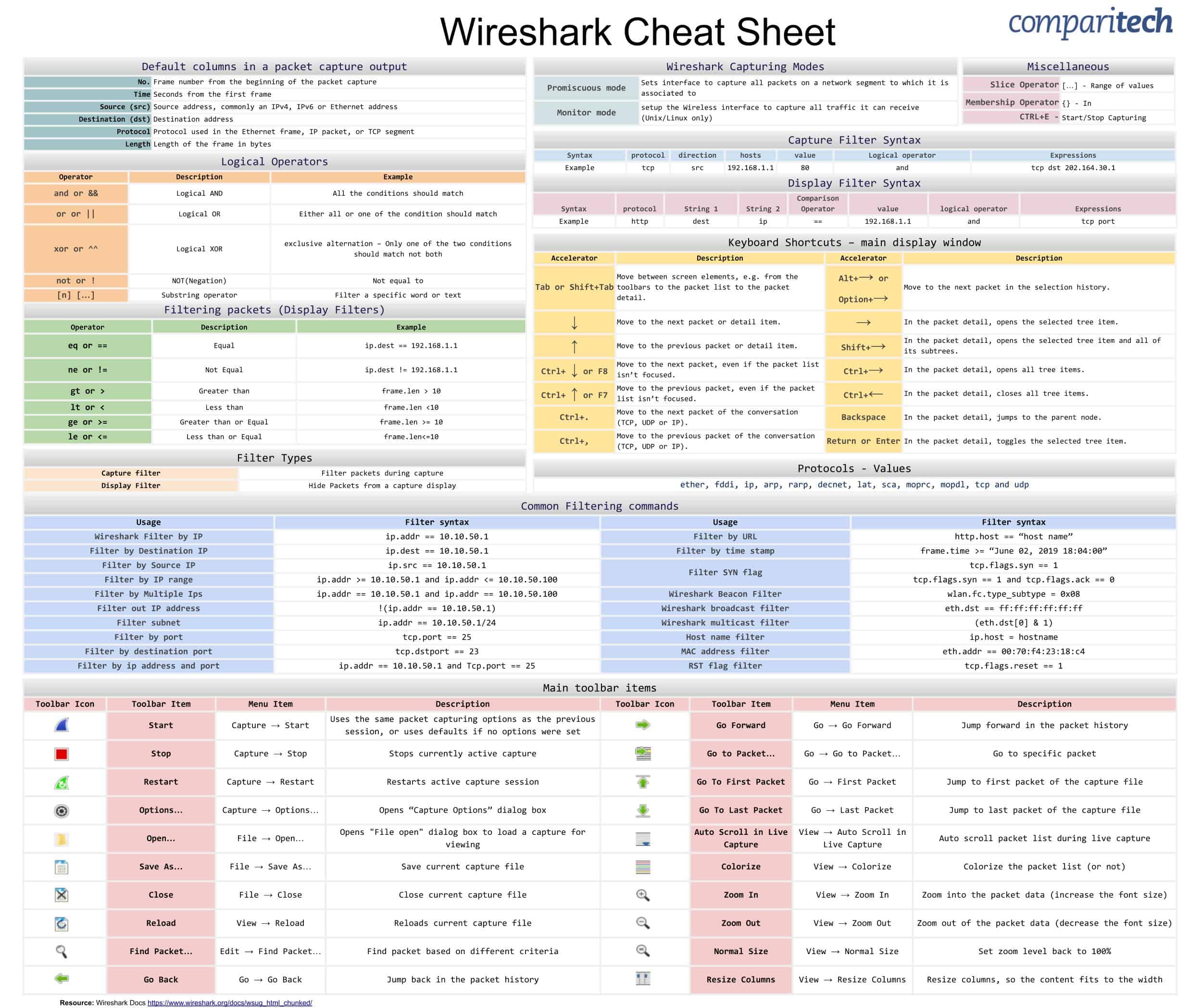How To Delete A Display Filter Button In Wireshark
We are reader supported and may receive a commission when you make purchases using the links on our site.
Wireshark Cheat Canvas – Commands, Captures, Filters & Shortcuts
Wireshark is an essential tool for network administrators, but very few of them get to unleash its full potential. Having all the commands and useful features in the 1 identify is leap to heave productivity. So nosotros put together a power-packed Wireshark Cheat Canvas. You tin download information technology for gratuitous as a PDF or JPG.
UPDATED: Feb 8, 2022

All the information that has been provided in the cheat canvass is as well visible further downwards this page in a format that is easy to re-create and paste.
The cheat sheet covers:
-
- Wireshark Capturing Modes
- Filter Types
- Capture Filter Syntax
- Display Filter Syntax
- Protocols – Values
- Filtering packets (Brandish Filters)
- Logical Operators
- Default columns in a packet capture output
- Miscellaneous Items
- Keyboard Shortcuts
- Mutual Filtering Commands
- Main Toolbar Items
View or Download the Cheat Sail JPG image
Correct-click on the paradigm below to relieve the JPG file ( 2500 width ten 2096 height in pixels), or click here to open it in a new browser tab. One time the image opens in a new window, you may demand to click on the prototype to zoom in and view the full-sized jpeg.

View or Download the cheat canvas JPG image
Click on the link to download the Crook Sheet PDF. If it opens in a new browser tab, simply correct click on the PDF and navigate to the download selection.
What'due south included in the Wireshark cheat sheet?
The following categories and items accept been included in the cheat sheet:
Wireshark Capturing Modes
| Wireshark Capturing Modes | ||||||||||||
|---|---|---|---|---|---|---|---|---|---|---|---|---|
| Promiscuous manner | Sets interface to capture all packets on a network segment to which information technology is associated to | |||||||||||
| Monitor way | setup the Wireless interface to capture all traffic it can receive (Unix/Linux only) | |||||||||||
Filter Types
| Filter Types | |||||
|---|---|---|---|---|---|
| Capture filter | Filter packets during capture | ||||
| Display Filter | Hide Packets from a capture display | ||||
Capture Filter Syntax
| Capture filter Syntax | |||||||||||||||||||
|---|---|---|---|---|---|---|---|---|---|---|---|---|---|---|---|---|---|---|---|
| Syntax | protocol | direction | hosts | value | Logical operator | Expressions | |||||||||||||
| Example | tcp | src | 192.168.one.one | lxxx | and | tcp dst 202.164.30.1 | |||||||||||||
Display Filter Syntax
| Display Filter Syntax | |||||||||||||||||||
|---|---|---|---|---|---|---|---|---|---|---|---|---|---|---|---|---|---|---|---|
| Syntax | protocol | Cord 1 | String ii | Comparing Operator | value | logical operator | Expressions | ||||||||||||
| Example | http | dest | ip | == | 192.168.one.ane | and | tcp port | ||||||||||||
Protocols – Values
| Protocols - Values | |||||||||||||
|---|---|---|---|---|---|---|---|---|---|---|---|---|---|
| ether, fddi, ip, arp, rarp, decnet, lat, sca, moprc, mopdl, tcp and udp |
Filtering packets (Brandish Filters)
| Filtering packets (Display Filters) | |||||||
|---|---|---|---|---|---|---|---|
| Operator | Description | Example | |||||
| eq or == | Equal | ip.dest == 192.168.1.1 | |||||
| ne or != | Not Equal | ip.dest != 192.168.1.1 | |||||
| gt or > | Greater than | frame.len > 10 | |||||
| lt or < | Less than | frame.len <10 | |||||
| ge or >= | Greater than or Equal | frame.len >= ten | |||||
| le or <= | Less than or Equal | frame.len<=10 | |||||
Miscellaneous Items
| Miscellaneous | |||||||
|---|---|---|---|---|---|---|---|
| Slice Operator | […] - Range of values | ||||||
| Membership Operator | {} - In | ||||||
| CTRL+E - | Start/Stop Capturing | ||||||
Logical Operators
| Logical Operators | ||||||||||
|---|---|---|---|---|---|---|---|---|---|---|
| Operator | Description | Example | ||||||||
| and or && | Logical AND | All the conditions should match | ||||||||
| or or || | Logical OR | Either all or one of the condition should lucifer | ||||||||
| xor or ^^ | Logical XOR | exclusive alternation – Only one of the two weather condition should match not both | ||||||||
| non or ! | NOT(Negation) | Not equal to | ||||||||
| [n] […] | Substring operator | Filter a specific discussion or text | ||||||||
Default columns in a packet capture output
| Default columns in a packet capture output | |||||||
|---|---|---|---|---|---|---|---|
| No. | Frame number from the first of the parcel capture | ||||||
| Time | Seconds from the offset frame | ||||||
| Source (src) | Source address, commonly an IPv4, IPv6 or Ethernet address | ||||||
| Destination (dst) | Destination address | ||||||
| Protocol | Protocol used in the Ethernet frame, IP packet, or TCP segment | ||||||
| Length | Length of the frame in bytes | ||||||
Keyboard Shortcuts
| Keyboard Shortcuts – primary display window | |||||||||||||||||||
|---|---|---|---|---|---|---|---|---|---|---|---|---|---|---|---|---|---|---|---|
| Accelerator | Description | Accelerator | Clarification | ||||||||||||||||
| Tab or Shift+Tab | Move between screen elements, due east.chiliad. from the toolbars to the packet list to the packet particular. | Alt+ → or Option+ → | Move to the side by side bundle in the choice history. | ||||||||||||||||
| ↓ | Move to the adjacent bundle or detail particular. | → | In the parcel item, opens the selected tree item. | ||||||||||||||||
| ↑ | Move to the previous packet or detail item. | Shift+ → | In the package detail, opens the selected tree item and all of its subtrees. | ||||||||||||||||
| Ctrl+ ↓ or F8 | Move to the next packet, even if the packet list isn't focused. | Ctrl+ → | In the bundle item, opens all tree items. | ||||||||||||||||
| Ctrl+ ↑ or F7 | Motion to the previous parcel, even if the packet listing isn't focused. | Ctrl+ ← | In the bundle item, closes all tree items. | ||||||||||||||||
| Ctrl+. | Motion to the next packet of the conversation (TCP, UDP or IP). | Backspace | In the parcel item, jumps to the parent node. | ||||||||||||||||
| Ctrl+, | Move to the previous packet of the conversation (TCP, UDP or IP). | Return or Enter | In the packet detail, toggles the selected tree particular. | ||||||||||||||||
Common Filtering Commands
| Usage | Filter syntax |
|---|---|
| Wireshark Filter by IP | ip.addr == 10.10.50.ane |
| Filter by Destination IP | ip.dest == 10.ten.50.one |
| Filter by Source IP | ip.src == 10.ten.l.i |
| Filter by IP range | ip.addr >= 10.x.50.1 and ip.addr <= 10.10.50.100 |
| Filter by Multiple Ips | ip.addr == 10.10.50.one and ip.addr == 10.10.50.100 |
| Filter out/ Exclude IP address | !(ip.addr == 10.10.50.i) |
| Filter IP subnet | ip.addr == 10.10.50.1/24 |
| Filter by multiple specified IP subnets | ip.addr == 10.10.50.one/24 and ip.addr == 10.10.51.1/24 |
| Filter by Protocol |
|
| Filter by port (TCP) | tcp.port == 25 |
| Filter by destination port (TCP) | tcp.dstport == 23 |
| Filter by ip address and port | ip.addr == 10.10.50.i and Tcp.port == 25 |
| Filter past URL | http.host == "host proper noun" |
| Filter by time postage | frame.fourth dimension >= "June 02, 2019 18:04:00" |
| Filter SYN flag | tcp.flags.syn == one tcp.flags.syn == one and tcp.flags.ack == 0 |
| Wireshark Beacon Filter | wlan.fc.type_subtype = 0x08 |
| Wireshark circulate filter | eth.dst == ff:ff:ff:ff:ff:ff |
| WiresharkMulticast filter | (eth.dst[0] & i) |
| Host name filter | ip.host = hostname |
| MAC address filter | eth.addr == 00:70:f4:23:18:c4 |
| RST flag filter | tcp.flags.reset == 1 |
Main Toolbar Items
![]()
| Main toolbar items | |||
|---|---|---|---|
| Toolbar Icon | Toolbar Item | Carte Item | Clarification |
| Start | Capture → Start | Uses the same parcel capturing options as the previous session, or uses defaults if no options were fix | |
| Stop | Capture → End | Stops currently active capture | |
| Restart | Capture → Restart | Restarts active capture session | |
| Options… | Capture → Options… | Opens "Capture Options" dialog box | |
| Open up… | File → Open up… | Opens "File open" dialog box to load a capture for viewing | |
| Relieve As… | File → Save As… | Save current capture file | |
| Shut | File → Shut | Close current capture file | |
| Reload | View → Reload | Reloads current capture file | |
| Observe Parcel… | Edit → Find Packet… | Find packet based on different criteria | |
| Become Back | Go → Go Back | Jump back in the packet history | |
| Go Forward | Become → Go Frontwards | Jump forwards in the packet history | |
| Get to Bundle… | Get → Go to Packet… | Go to specific bundle | |
| Go To First Bundle | Go → First Packet | Jump to first packet of the capture file | |
| Go To Last Packet | Go → Last Parcel | Jump to last parcel of the capture file | |
| Machine Scroll in Live Capture | View → Car Coil in Live Capture | Automobile gyre packet list during live capture | |
| Colorize | View → Colorize | Colorize the parcel list (or not) | |
| Zoom In | View → Zoom In | Zoom into the packet data (increase the font size) | |
| | Zoom Out | View → Zoom Out | Zoom out of the package data (decrease the font size) |
| Normal Size | View → Normal Size | Set zoom level dorsum to 100% | |
| Resize Columns | View → Resize Columns | Resize columns, so the content fits to the width | |
More Wireshark tutorials:
- Wireshark crook sheet
- How to decrypt SSL with Wireshark
- Using Wireshark to become the IP address of an Unknown Host
- Running a remote capture with Wireshark and tcpdump
- Wireshark 'no interfaces found' error explained
- Identify hardware with OUI lookup in Wireshark
- All-time Wireshark alternatives
How To Delete A Display Filter Button In Wireshark,
Source: https://www.comparitech.com/net-admin/wireshark-cheat-sheet/
Posted by: longcomem1980.blogspot.com


0 Response to "How To Delete A Display Filter Button In Wireshark"
Post a Comment